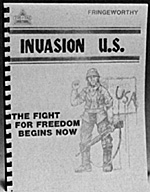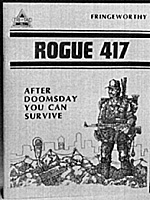
Written by Richard Tucholka
Tri-lac Inc.
PO. Box 61, Madison Heights, MI 48071
Released: 1984
Catalog No.: 4050, 4001
Price: $5.95, $5.95
Complexity: Intermediate
Solitaire Suitability: None
Rogue 417 and Invasion U.S. are campaign settings for Tri-Tacs Fringewordly role-playing game--or, really, for any of Tri-Tacs RPGs, which are all written upon the same basic game system. Rogue 417 is a 32-page 8 1/2" x 11" booklet with standard saddlestitch binding; Invasion U.S. is the same size and page count, hut is spiral-bound with the sort of plastic spiral binding you find in college campus copying shops.
Rogue 417 has a post-holocaust campaign setting. In such settings, the world as we know it is no more, and civilization consists of isolated pockets of humanity surrounded by monster-inhabited wasteland. The monsters in question are usually nasty people or mutated animals and humans. Post-holocaust games and settings traditionally rely on World War III to destroy civilization. Tri-Tac, instead, has the worid wrecked by the ravages of Rogue 417, an engineered virus that reduces the world population by 85 percent in the course of a year.
Invasion U.S. is, in no uncertain terms, "Red Dawn"--the recent movie about Russian/Cuban invasion of the U.S., rendered into game terms. The history of the invasion has seen some nominal changes to disguise the suhject~ origin, and the text deals a great deal more with the "townies" than the movie did-but it's still "Red Dawn.
Rogue 417 and Invasion U.S. tend to share a number of strong and weak. points. Unfortunatelv for both the buyer and TriTac, the weak points are more common than the strong points. Both supplements contain a nominal future-history write up which describes the destruction of present day culture. There are descriptions of various people such as survivalists, crazies, rebels, and Russian KGB men that one can encounter while playing in these campaign settings. An enormous number of charts and tables are supposed to be useful to the Gamemaster, such as Occupied America Prices table, Black Market table, Arrest/ Punishment Severity tables, Prison Survival Probability table, Found Objects table, Hidden Dangers table, and Farming and Crop Yield tables. A couple of scenario outlines are also added.
One of the few strengths of the products comes from the tabular material. If you're a Gamemaster who uses such data on a regular basis, Rogue 417 and Invasion U.S. can he very useful to you--regardless of which game svstem you normally use, The few Fringewortby game mechanics which play a part in these supplements can be converted with a minimum of effort to other role-plaving systems.
But, Gamemasters with little interest in seeing table after table won't find much to use in these releases. There reallv isn't much material to help you role-play these situations.
 The future histories are brief, and actually, disinteresting. For instance, the Rogue 417 virus destroyed most of the worlds population in a fairly clean manner, compared to nuclear war. This is a plus, but the history doesn't involve us in the after effects of the virus' release and doesn't convey any feeling for what the world is now Additionally the campaign is
set only a few years in our future--not long enough for really peculiar mutations
or communities to have developed. This results in a more realistic setting, but
frankly, its fairly boring. The Invasion U.S. history tells us about the invasion as
though it were in the immediate past, but doesn't describe how to game it as the start
of your campaign. As anyone who's seen "Red Dawn" knows. the actual invasion is
one of the most interesting things you can game.
The future histories are brief, and actually, disinteresting. For instance, the Rogue 417 virus destroyed most of the worlds population in a fairly clean manner, compared to nuclear war. This is a plus, but the history doesn't involve us in the after effects of the virus' release and doesn't convey any feeling for what the world is now Additionally the campaign is
set only a few years in our future--not long enough for really peculiar mutations
or communities to have developed. This results in a more realistic setting, but
frankly, its fairly boring. The Invasion U.S. history tells us about the invasion as
though it were in the immediate past, but doesn't describe how to game it as the start
of your campaign. As anyone who's seen "Red Dawn" knows. the actual invasion is
one of the most interesting things you can game.
There are no interesting non-player characters (NPCs) presented, Oh, you see brief descriptions of pacifists, occupying troops, gunsmiths, and foreigners-but there aren't any people here. When refereeing, I tend to get more ideas from complete descriptions of significant NPCs than from amalgamating tabular data.
There is no real advice on how to set up and run a post-holocaust or "Red Dawn" World. Yes, there are the tables which tell you how much black-market gasoline costs, but where is the advice to help impress the characters with how devastated their world now is? Where are the notes on plotting stories in the campaign? Where are the feel, the flavor, the personality of post-holocaust or "Red Dawn" adventures?
They're not in these two supplements. And, as usual, Tri-Tacs physical presentation is substandard. The print is letter-quality computer printing, not typesetting. That, plus the poor art and unimaginative layout, make these two supplements painfull viewing from cover to cover. It would be nice if they would improve the quality of their products.
Of the two supplements, Invasion U.S. is probably the more useful, Post-holocaust has been done much more imaginatively, but this is the first "Red Dawn" to hit the gaming fields shelves. In general, I can recommend Rogue 417 and Invasion U.S. only if you're a die-hard fan of Tri-Tacs RPGs, or you're a Gamemaster who likes lots and lots of material presented in tabular form.
Aaron Allston is a freelance writer and editor of Adventurers Club magazine for Hero Games. Allston was formerly senior editor to Steve Jackson Games Incorporated, and editor of Space Gamer and Fantasy Gamer.
More Reviews
-
Game Review: Panzer Command
Game Review: Southern Front (WWIII)
Game Review: Liddell Hart's Second World War
Game Review: Royal Navy
Game Review: Hitler's War
Game Review: Sixtomania
Game Review: Rush Hour
Game Review: Constellation
Game Review: Dr. Who
Game Review: Invasion US, Rogue 417
Game Review: Fringeworthy (sci-fi RPG)
Game Review: Super Squadron (Superhero RPG)
Back to Table of Contents -- Game News #3
To Game News List of Issues
To MagWeb Master Magazine List
© Copyright 2000 by Dana Lombardy.
This article appears in MagWeb (Magazine Web) on the Internet World Wide Web.
Other military history articles and gaming articles are available at http://www.magweb.com